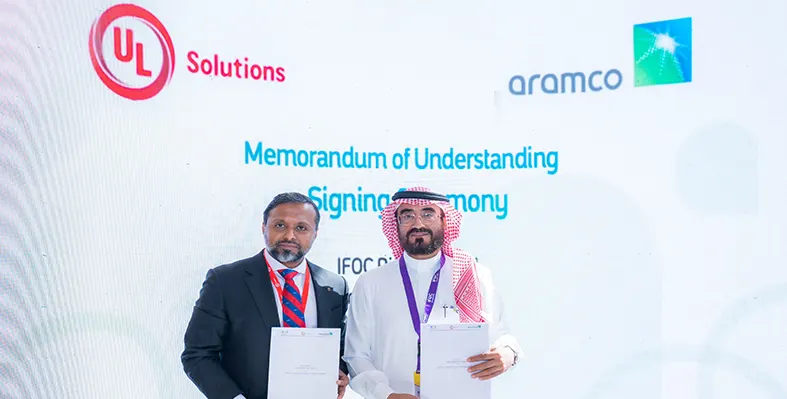-

What’s Behind the Errors We Make?
?️ Editorial Introduction:
Have you ever stopped to think about what’s really behind the small mistakes we make every day? Those seemingly harmless slips can have major consequences—both at work and in everyday life. Larry Wilson, CEO and author of SafeStart, shares powerful insights into the unexpected causes of these errors—and how we can protect ourselves.
? Description (50 words):
What causes the errors that lead to accidents—even during simple tasks? In this video, Larry Wilson uncovers the human factors behind everyday mistakes and explains how we can reduce risk by understanding our own behaviour. A must-watch for anyone interested in safety, awareness, and accident prevention.
-

SafeStart Event
Breaking New Ground: SafeStart's First Public Workshop in Dubai a Huge Success!
The SafeStart Trainer Certification Level 1 Course made a powerful debut in Dubai on February 18-19, bringing together top companies from across the Middle East in a sold-out, high-energy event.
With a full house and an engaged audience, the workshop sparked meaningful discussions, personal stories, and hands-on learning about human factors and Critical Error Reduction Techniques (CERTs). Participants explored what really happens when we are rushing, frustrated, fatigued, or complacent—and, more importantly, how to self-trigger on these states to prevent errors before they lead to incidents.
As safety professionals, we often tell workers to stop and think before committing to a task, but we rarely explain what to think about. SafeStart fills this gap by helping individuals rate their state before taking action:- Am I rushing?
- Am I tired?
- Am I at risk of making a critical error?
By developing these lifesaving skills, SafeStart helps stop the domino effect that can lead to accidents—even fatalities.
This was just the beginning! Stay tuned for the next SafeStart workshop in the Middle East, and be part of this life-changing experience.
?This email address is being protected from spambots. You need JavaScript enabled to view it. to secure your spot!
Want to know more about SafeStart? Visit our website. -

E-HSE: Next Revolution Panel: Oman HSE Forum
The third session at HSE Oman Forum 2021 on 'E-HSE Next Revolution in Oman' engaged our audience with insights on Petroleum Development Oman's IHTIMAM system. Port of Salalah highlighted the use of digitized capture to enhance HSE systems and Esteshraf Foresight talked about the importance of setting realistic compliance targets.
-

-

Risk Overview Session: Oman HSE Forum
HSE Oman Forum's session on 'Risk Overview' hosted panellists from Oman Drydock Company (ODC), Oman Electricity Transmission Company and Petroleum Development Oman who discussed safety challenges, initiatives to ensure skilled human resources for lifting operations and the 12 Golden Rules (life saving) of ODC.
Muscat, Oman
Intersec 2025 sets new benchmark for global safety and security
A record number of exhibitors representing 61 countries have participated in the 26th edition of Intersec, the largest business event in the world that maps the future of security, safety, and fire protection.
The largest edition of the event took up 61,000 sq m of space at the Dubai World Trade Centre (DWTC), a 20% increase from the previous year.
Under the auspices of His Highness Sheikh Mansoor Bin Mohammed bin Rashid Al Maktoum, the event, which ended last month, drew 47,300 visitors from 142 countries and featured state-of-the-art technologies and vital solutions in five major areas: Homeland Security & Policing, Cyber Security, Safety & Health, Fire & Rescue, and Commercial & Perimeter Security. The show's theme was "Mapping the Future of Security, Safety, and Fire Protection."
Among the new features this year was the successful opening of the two-day Intersec Policing Conference, which brought together more than fifty knowledgeable speakers. Discussions covered a wide range of subjects, including the future of road safety, proactive and productive policing, strategic automation in policing, drone operations, and quantum-led crime. Senior law enforcement officials from the Abu Dhabi Police, INTERPOL, the Metropolitan Police, and the UAE Financial Intelligence Unit were among them.
The top Chief Information Security Officers (CISO) in the area were also invited to the CISO Business Briefing, which was successfully launched while examining the main information security trends, threats, and opportunities. The opening keynote speaker was H.E. Dr. Mohamed Al Kuwaiti, Head of Cybersecurity, UAE Government.
The annual awards
The exhibition's ground-breaking collaboration with Ignyte, which resulted in the opening of the Intersec Startup Arena, was another first. It gave startups a chance to present their innovative ideas and solutions to a group of government officials, business executives, and elite investors, opening doors for them to secure investment, mentorship, and strategic alliances.
ASIS International, Firestop Contractors International Association (FCIA), Gallagher, Sharjah Civil Defence, NAFFCO, Abu Dhabi Civil Defence, Nordon, Saudi Sicli, and UXE Security Solutions were among the companies that signed Memorandums of Understanding (MoUs) during the three-day event held by Intersec 2025.
Several industry leaders were honoured at the 4th annual Intersec Awards, which honour people, groups, and organisations for establishing new benchmarks for excellence in vital sectors.
Winners on the evening included Dubai Civil Defense, NAFFCO, Dubai Municipality, Ministry of Interior, Emirates Safety Laboratory LLC, and the Telecommunications and Digital Government Regulatory Authority (TDRA).
Wajahat Hussain, show manager, Messe Frankfurt Middle East, said, “The team and I are thrilled to have welcomed an unprecedented gathering of industry professionals from around the world. Intersec has once again proven to be the premier platform where global leaders, innovators, and experts converge to exchange knowledge, forge partnerships, and explore cutting-edge advancements that are shaping the future of safety, security, and fire protection.
“Surpassing previous exhibitor records is a testament to Intersec’s growing influence and its pivotal role in driving forward-thinking solutions for a safer, more secure world. This milestone underscores our commitment to fostering collaboration, showcasing pioneering technologies, and setting new benchmarks for excellence in this critically important industry.”
Intersec 2026 will take place from 12 – 14 January 2026 at the Dubai World Trade Centre.
How AI and digitalisation are revolutionising health and safety
A new report from the International Labour Organization (ILO) explores how AI, digitalisation, robotics and automation are improving worker health and wellbeing in workplaces worldwide, while underlining the need for proactive policies to ensure these technologies are implemented safely and equitably
The report, titled Revolutionizing Health and Safety: The Role of AI and Digitalization at Work, highlights how robots help reduce risks and improve efficiency by taking on hazardous tasks, assisting in surgeries, and optimising logistics. AI-powered systems enhance safety and health monitoring, and streamline tasks and operations, easing workloads and driving innovation – even in traditionally low-tech sectors.
“Digitalisation offers immense opportunities to enhance workplace safety. Robots can replace workers in hazardous ‘3D jobs’, which can be dirty, dangerous, and demeaning. Automation can reduce repetitive tasks, such as in factory production lines or in administrative work, allowing workers to take on more challenging tasks,” said Manal Azzi, team lead on OSH Policy at the ILO. “But for us to fully benefit from these technologies, we must ensure they are implemented without incurring new risks.”
Technology’s impact on safety and health
The report highlights that advanced robotics and automation, the use of virtual and extended reality, as well as new tools such as smart wearable devices that provide real-time risk detection or environmental sensors that track air quality, are transforming safety and health by preventing accidents and reducing hazardous exposures. Furthermore, digitalisation is leading to the rise of hybrid and remote work arrangements that are creating flexibility and improving mental health.
VR is transforming training by providing immersive, interactive experiences for high-risk environments that are difficult to simulate theoretically, such as emergency response, fire training and working at heights. The report highlights an example from Qatar, where The Qatar Ministry of Labour, in cooperation with the ILO, launched a VR-based training programme for labour inspectors, which enhances OSH enforcement by allowing inspectors to explore virtual construction sites, identify workplace risks and correct safety violations without entering hazardous environments. The programme also improves guidance for employers and workers, strengthening compliance with OSH standards.
However, these advancements may also bring in new risks. While robots effectively take on hazardous tasks, workers who maintain, repair, or collaborate with these machines may face new dangers. Unpredictable robotic behaviours, system failures, or cyber threats can compromise safety. Ergonomic risks may arise from human-robot interaction, as well as from the use of wearables and exoskeletons that lack proper fit, usability, or comfort.
The study highlights that over-reliance on AI and automation may reduce human oversight, which would, in turn, increase OSH risks, while algorithm-driven workloads and being continuously connected can contribute to stress, burnout, and mental health issues.
The report also exposes safety and health risks faced by workers across the digital supply chain, from those in extraction processes to those powering AI, as well as workers handling electronic waste.
Global policy response and the role of the ILO
The report highlights regulatory gaps in managing OSH risks linked to digitalisation and calls for stronger global, regional, and national policies. The ILO’s OSH conventions (Nos. 155 and 187) provide a foundation for ensuring the right to a safe and healthy workplace in the digital era.
Policies and regulations worldwide increasingly include new measures covering robotic safety and human-robot interaction, the right to disconnect, improved algorithmic management of work, and safe telework and platform work.
Worker involvement is essential at every stage of technology adoption, the report argues. Training and awareness raising initiatives are key to ensuring safe use of new technologies. Further research will be needed to fully understand the long-term occupational safety and health impacts of digital transformation.

The platform will allow pipeline operators to practice response to pipeline incidents in a controlled environment. (Image source: Adobe Stock)
AI-driven gaming platform set to enhance pipeline safety
An AI-driven gaming platform being developed by the Mary Kay O’Connor Process Safety Center (MKO) at Texas A&M University and EnerSys Corporation allows pipeline operators to be exposed to pipeline incidents in a controlled environment and gain experience in responding to real-world scenarios.
Pipeline leaks or failures can have a catastrophic impact on assets, people and the environment as well as causing untold financial and reputational damage. In early April this year, for example, a leaking gas pipeline sparked a huge fire on the outskirts of Malaysia’s capital Kuala Lumpur, injuring more than 100 people.
The project aims to develop a realistic training system for teams to practice handling hazardous condition response and emergency response in a collaborative learning environment. It simulates various pipeline failure scenarios, using AI to visualise how such situations can evolve, and provides measurable outcomes of the response, so that when incidents do occur, people working with pipelines can be prepared and respond more quickly and effectively.
According to an article on the Texas A&M website, MKO will provide knowledge and understanding of the pipeline and its safety issues and create mathematical models for the project, while EnerSys Corporation will facilitate research and data collection from industry.
Trial scenarios with a research and development team are planned by the end of this year, with results being incorporated into the platform.
“It’s a great opportunity for us to learn, particularly from the industrial experiences, and develop tools that enable fusion of knowledge and experience to improve safety,” said Faisal Khan, director of the Mary Kay O-Connor Process Safety Center.
A new report by the International Labour Organization (ILO) on ‘Revolutionizing health and safety: the role of AI and digitalization at work’ highlights the effectiveness of immersive virtual training environments, allowing workers to acquire new skills quickly and retain knowledge more efficiently, thereby providing a better trained and more competent workforce.
“The technology presents an important opportunity to improve the effectiveness of safety and safety-relevant training due to its abilities both to allow trainees to fail safely and to present scenarios that are difficult to replicate in the real world, either due to financial constraints or safety concerns,” it says.
EU-OSHA unveils new publications about 'invisible' HSE risks
As EU-OSHA research reveals that tech innovation and emerging mental health issues are impacting workers, the association has unveiled a suite of resources (including dedicated publications) about the risks of 'invisible' challenges in the workplace
A dedicated 11-page publication, 'Electromagnetic fields: present and future challenges for occupational safety and health', examines the risks of electromagnetic fields, such as cancer, and discusses how excitement around the opportunities that EMFs present cannot be divorced from the risks and challenges they introduce to occupational health and safety.
Similarly invisible yet almost as devastating are the risks proposed by mental health challenges in the workplace. One such issue has been dubbed 'eco-anxiety', and refers to the worry induced by climate change and environmental damage. The 12-page 'Eco-anxiety and its implications for occupational safety and health' report hopes to explore how practitioners and policymakers can address eco-anxiety concerns and mental health challenges.
A full breakdown of emerging HSE risks and challenges has been added to EU-OSHA's website alongside the new publications.

Gerald V. Sims will assist Teledyne Gas and Flame Detection in further growing its market share. (Image source: TGFD)
Teledyne GFD to accelerate growth in the Americas
In an effort to spur expansion throughout the continent, Teledyne Gas and Flame Detection (Teledyne GFD) has appointed a new vice president of sales and marketing for the Americas.
Gerald V. Sims will assist Teledyne Gas and Flame Detection in further growing its market share in this significant geographic market thanks to his extensive experience in gas utilities and his proven track record of sales leadership.
Over many years, Teledyne GFD has been expanding throughout the Americas. Teledyne Detcon, the company's US manufacturing facility in Cypress, Texas, has been offering industrial-grade gas detectors, control systems, analysers, and wireless technologies to the gas detection market for more than 40 years.
“Gerald will use his expertise and deep industry knowledge to play a pivotal role in maximising our growth potential and enhancing the presence of our product brands across the Americas,” said Thibault Fourlegnie, vice president and general manager, Teledyne Gas and Flame Detection. “We’re excited to see the gains that Gerald can provide, not just for Teledyne Gas and Flame Detection, but also for our customers. After all, an even stronger Teledyne Gas and Flame Detection is beneficial for stakeholders up and down the supply chain, including distributors and end users.”

The new uvex phynomic cut glove range is manufactured in Germany using 3D hand ‘formas’ to mimic the contours of the hand. (Image source: uvex)

Dubai Electricity and Water Authority (DEWA) organised 61 training courses and awareness sessions on occupational health and safety during the first half of 2024, with the participation of 2,110 male and female employees from various divisions. (Image source: DEWA)
DEWA organises training courses for HSE
Dubai Electricity and Water Authority (DEWA) conducted 61 training courses and awareness sessions on occupational health and safety in the first half of 2024.
These sessions saw the participation of 2,110 employees from various departments. This initiative is part of DEWA's ongoing efforts to enhance its employees' knowledge and skills in occupational health and safety.
Trainings throughout the year
“We are dedicated to effectively implementing quality, health, safety, and environmental management systems according to the highest international standards. We strive to cultivate a culture of occupational safety and health among all employees, enabling them to keep pace with the latest developments in this field. This is part of our responsibility towards our employees, customers, and the employees of suppliers and contractors who work on DEWA’s projects. Additionally, we are committed to providing our services according to the highest standards of quality, efficiency, availability, and reliability,” said HE Saeed Mohammed Al Tayer, CEO of DEWA.
“We offer the best training and awareness programmes to enhance the safe work environment and raise health and safety standards across all DEWA’s projects and operations. This contributes to achieving employees’ happiness and enhances productivity and quality,” said Dr. Yousef Al Akraf, executive vice president of business support and human resources at DEWA.
In addition to the training courses, DEWA organises many events and awareness activities throughout the year. These include Public Health and Safety Week, Internal Health and Safety Week, Contractor Health and Safety Awareness Day, and other activities and events aimed at improving the health and safety systems of human resources. Employees who complete the training provided by DEWA staff are awarded certificates in occupational health and safety.





































